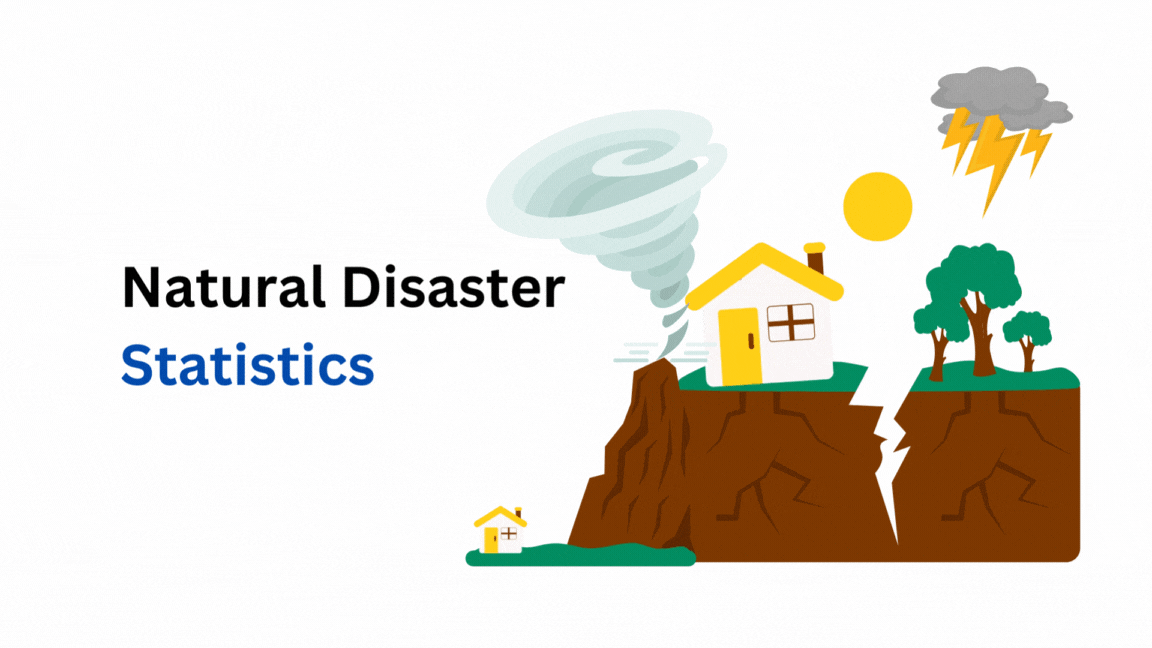Mental Health Statistics – By Demographic, Sources of Stress, Workplace and Country
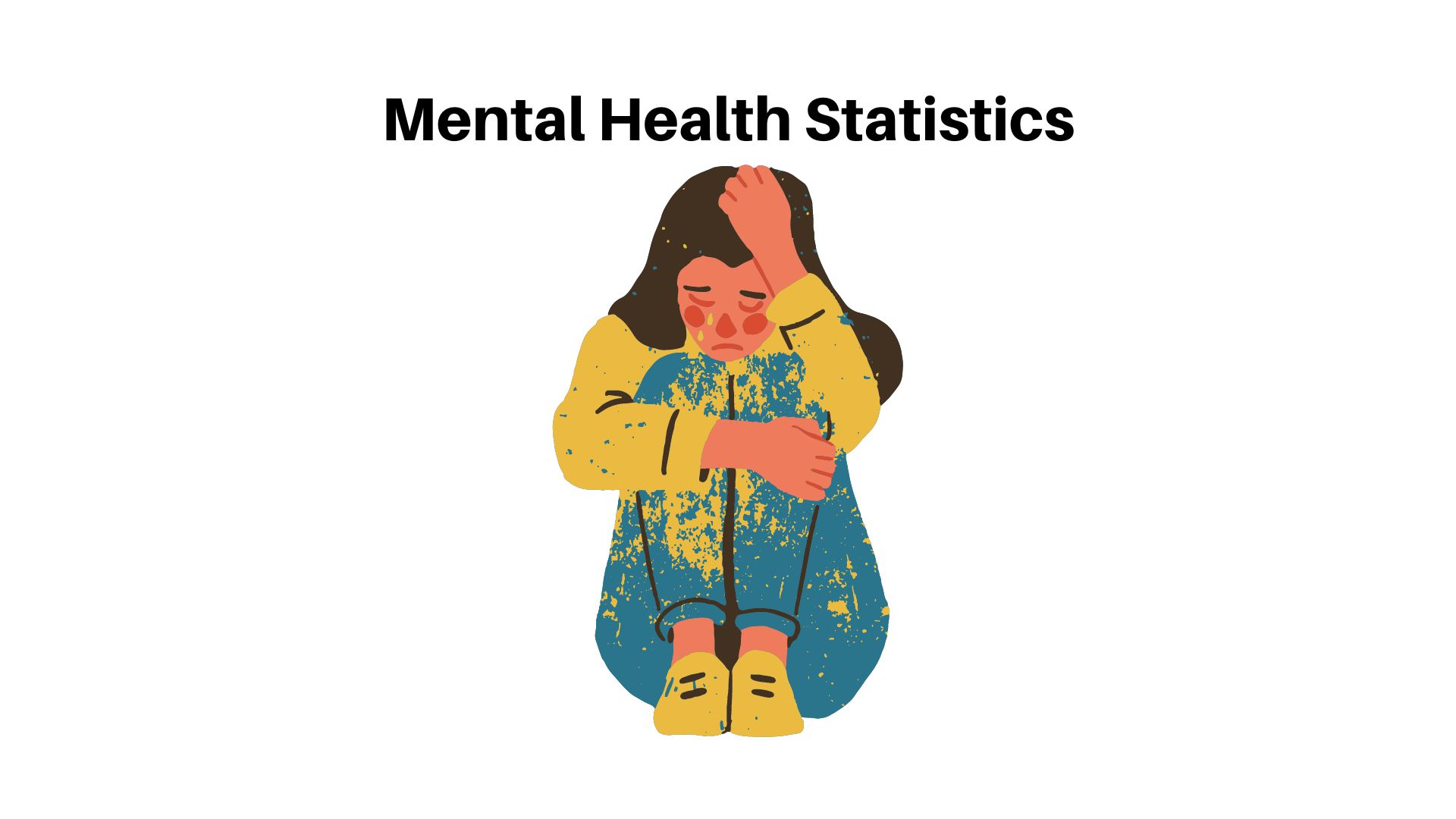
Page Contents
- Introduction
- Editor’s Choice
- What Refers To Mental Health?
- Causes Of Mental Health Disorders
- Categories of mental illness
- Treatments For Mental Health Disorders
- General Mental Health Statistics
- By Social Media Usage
- By Demographic
- By Income Group
- By Generation
- By Common Problems
- By Ethnic Group
- By Sources Of Stress
- By Workplace
- By Industry
- By Assistance Received
- By Treatment Received
- By No Assistance Received
- By Side Effects
- Mental Health Statistics By Country
- Conclusion
Introduction
Mental Health Statistics: Mental health issues have become severe since the pandemic. People were asked to lock themselves behind the four walls. Further, this issue was followed by the work-related stress of Working from home, family issues and responsibilities and up roaring of small kids, and many similar problems. Altogether this, mental health problems increased and yet they are being fully addressed. Taking care of such problems on a larger level is a must for every country. Companies as well as societies people living in should compel their employees and residents to do daily meditation.
These mental health statistics has designed to show some dark side of the world where people are still facing problems and are afraid to speak openly.
Editor’s Choice
- The difference in treatment between mental health illness and its treatment is 11 years.
- According to Mental health statistics, in the United States of America, such issues cause $193.3. billion loss to the economy.
- As of 2022, 42% of the people from Gen Z have mental health issues.
- Children with mental illness are more likely to repeat their schooling year 3 times.
- As of 2022, there were 47% of men, 45% of women and 6% of nonbinary, and 2% of transgender faced mental health problems.
- For people under the age of 45, mood disorder is a leading cause of hospitalization.
- 39% of people with mental health issues go to therapy every once a week.
- 15% of the employees talked to their bosses and 91% of them were supportive and only 9% were unsupportive.
- As of today, 70% of the young people in the juvenile justice system recorded a diagnosable mental health condition.
- 1 out of 4 Gen Z people was diagnosed with mental health problems before the pandemic.
What Refers To Mental Health?
Mental health refers to the psychological, emotional, and social well-being of any individual. The government of all countries addresses these issues under the public health section as this is a major problem for the past 2 years. Following are some causes of mental health disorders that are to some extent curable. The willpower of a person plays an important role in this case.
Causes Of Mental Health Disorders
- Critical long-term stress
- Domestic violence, abuse, bullying
- Career stress
- Trauma (severe life incidents in the military or accidents, conducted crime, etc.…)
- Physical conditions, neurological conditions, or head injury
- Excessive drinking problems.
- Long-term poverty or debt problems.
- Unemployment
- Rape
- Long-term physical health condition
- Discrimination such as racism
- Loneliness or isolation
- Childhood abuse, trauma
- Being homeless
- Any other situation which causes an extreme level of mental stress.
Categories of mental illness
- Bipolar and related disorders – frequent changes in excessive activity in energy, excitement, and depression in particular periods.
- Anxiety problems – Panic attacks and phobias.
- Depressive disorders – Controls the level of being happy or sad.
- Psychotic disorders – Hallucinations, delusions, and disorganization in thinking and speech.
- Neurodevelopmental disorders – learning disorders, hyperactivity disorder, and an autism spectrum disorder
- Feeding and eating problems – binge eating disorder, anorexia nervosa.
- Elimination disorders – Bedwetting
- Obsessive-compulsive disorders – hair pulling, hoarding disorder.
- Trauma or stress-related disorders – acute stress disorder and post-traumatic stress disorder
- Sleep-wake disorders – insomnia, restless legs syndrome, and sleep apnea.
- Sexual dysfunctions – premature ejaculation, sexual response disorder, and female orgasmic disorder.
- Paraphilic disorders – Pedophilic, voyeuristic, and sexual sadism disorders.
- Personality disorders – Antisocial, narcissistic, and borderline.
- Neurocognitive disorders – Brain injury or Alzheimer’s disease.
- Conduct disorders – loss in self-control of behavior,
- Addictive disorder –excessive drinking and eating habits of tobacco, coffee, drugs, or alcohol
- 17 Other mental disorders – other than above mentioned.
Treatments For Mental Health Disorders
- Antidepressants, anti-anxiety medications, Antipsychotic medications, and mood stabilizing medications.
- Talk to social workers, family members, physical assistants, nurse practitioners, family doctors, pharmacists, psychotherapists, and psychiatrists.
- Stay away from negative people.
- Do things that make you happy.
- Don’t do stressful things.
General Mental Health Statistics
- Mental health statistics say that 68% of the population around the state that the pandemic was the reason for the negative effect on the mind.
- On average, $149 is spent on medications every month.
- 39% of people with mental health issues go to therapy every once a week.
- Only 1 out of 5 people visit therapy sessions.
- 87% of the adults who visit therapy sessions said it is helpful.
- Patients feel most comfortable talking about their issues with Friends, siblings, and parents.
- In the United States of America, 8.4 million people give assistance to an adult with mental health problems.
- Caretakers of persons with problems serve 32 hours of unpaid caretaking activity.
- As per the mental health statistics, for people under the age of 45, mood disorder is a leading cause of hospitalization.
- 8% of people with severe mental health issues experience being homeless.
- According to Mental health statistics, in the United States of America, such issues cause $193.3. billion loss to the economy.
- As of today, 70% of the young people in the juvenile justice system recorded a diagnosable mental health condition.
- The difference in treatment between mental health illness and its treatment is 11 years.
- As per mental health statistics, there are around 970 million people suffering from mental illness.
- 3% of the deaths have been reported due to mental disorders resulting in 8 million.
By Social Media Usage
- Adults with mental health issues started using social media at 12 years of age.
- 1 out of 3 people has posted on social media about their mental health.
- 36% of the people with a similar problem have deleted their social media accounts.
- On average, a person takes a break from social media for 10 weeks if suffering any mental health problem.
- 57% of adults with the problem around the globe have taken a break from social networks.
By Demographic
- Women are more likely hit by mental health problems than men.
- As per the mental health statistics of 2022, there were 47% of men, 45% of women and 6% of nonbinary, and 2% of transgender faced mental health problems.
By Income Group
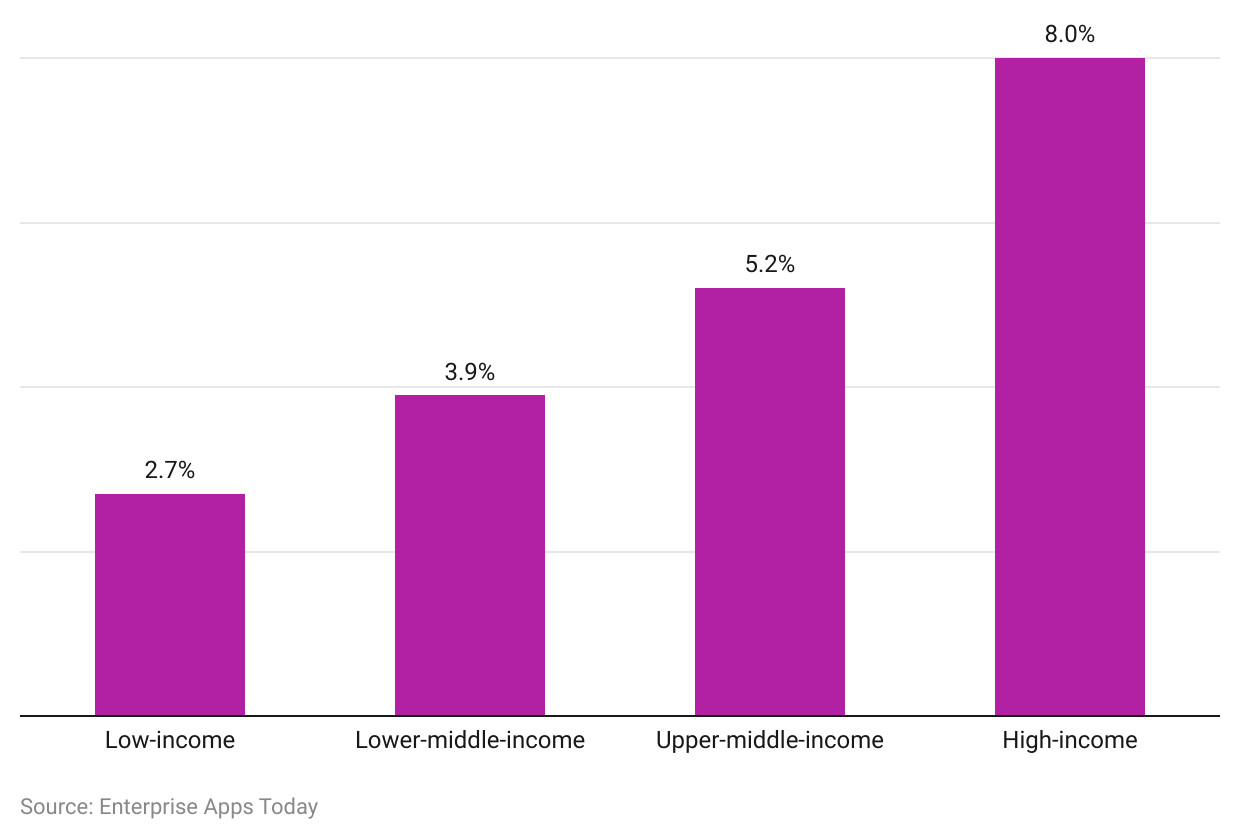 (Source: WHO)
(Source: WHO)
- There are 2.7% of the people facing mental health issues from low-income groups.
- 9% of the people are from the lower middle class and 5.2% belong to the upper middle-income class.
- Surprisingly, the highest number of people facing mental health issues are from high-income class groups.
By Generation
- 17% of millennials freely talk about mental health issues.
- On the other hand, 82% said baby boomers are not good enough to share about such problems.
- 79% of Gen Z people said they are more likely to understand these problems.
- According to Mental health statistics, Gen Z people are more likely to face mental health problems than any other generation.
- Children with mental illness are more likely to repeat their schooling year 3 times.
- As of 2022, 42% of the people from Gen Z have mental health issues.
- 1 out of 4 Gen Z people was diagnosed with mental health problems before the pandemic.
By Common Problems
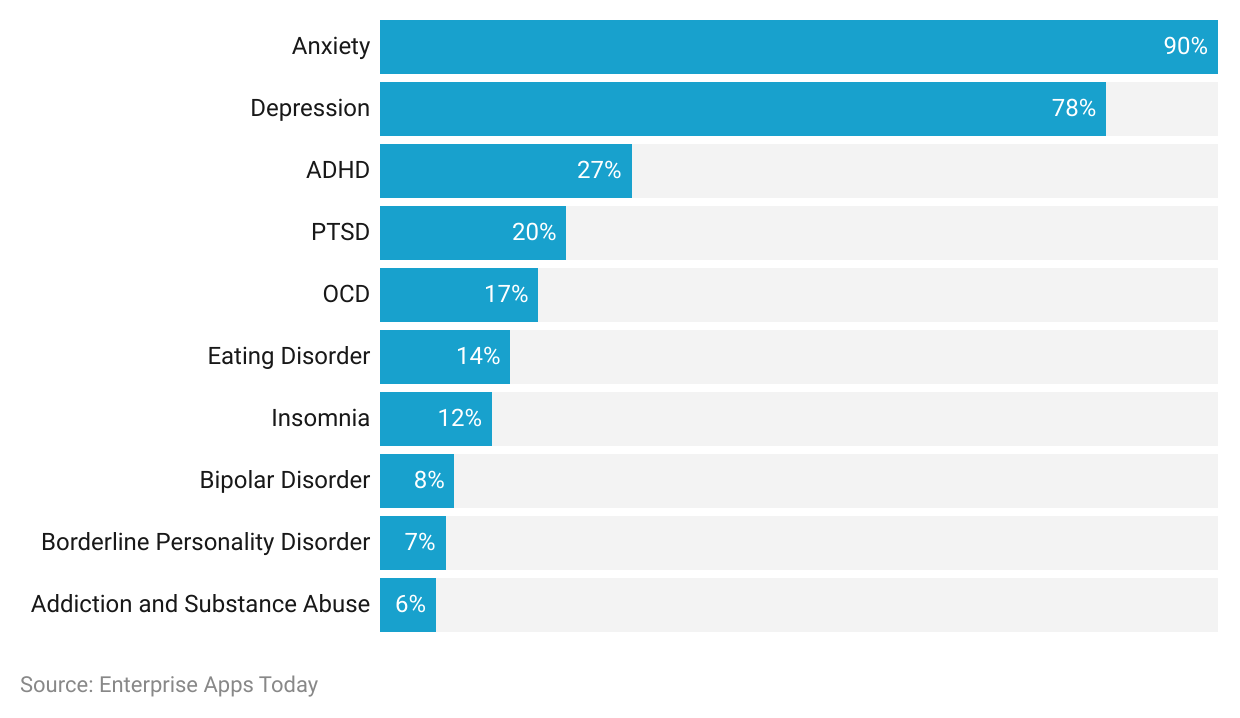 (Source: Harmony Healthcare IT)
(Source: Harmony Healthcare IT)
- According to mental health statistics, anxiety is a major problem leading to mental illness resulting in 90%.
- Depression contributes to mental illness by 78% while ADHD has 27%.
- PTSD and OCD are converted to mental illness at 20% and 17% respectively.
Similarly, other causes are as follows: Eating disorder (14%), Insomnia (12%), Bipolar disorder (8%), borderline personality disorder (7%), and addiction and substance abuse (6%).
By Ethnic Group
Annual treatment rates among U.S adults with any mental illness, by demographic group:
| Male | 37.4% |
| Female | 51.2% |
| Lesbian, Gay, or Bisexual | 54.3% |
| Non-Hispanic Asian | 20.8% |
| Non-Hispanic White | 51.89% |
| Non-Hispanic black or African-American | 37.1% |
| Non-Hispanic mixed/multiracial | 43.0% |
| Hispanic or Latino | 35.1% |
- In the United States of America, mental health statistics say that there are 37.4% of males and 51.2% of females are taking treatment for mental illness.
- Out of these demographic groups, 54.3% are lesbian, gay, or bisexual.
- 8% and 51.8% of the population belong to non-Hispanic Asian and white people.
- 1% are non-Hispanic black or African American people and 43% belong to non-Hispanic multiracial.
- And there are 35.1% of Hispanic or Latino people seeking treatment for mental illness.
By Sources Of Stress
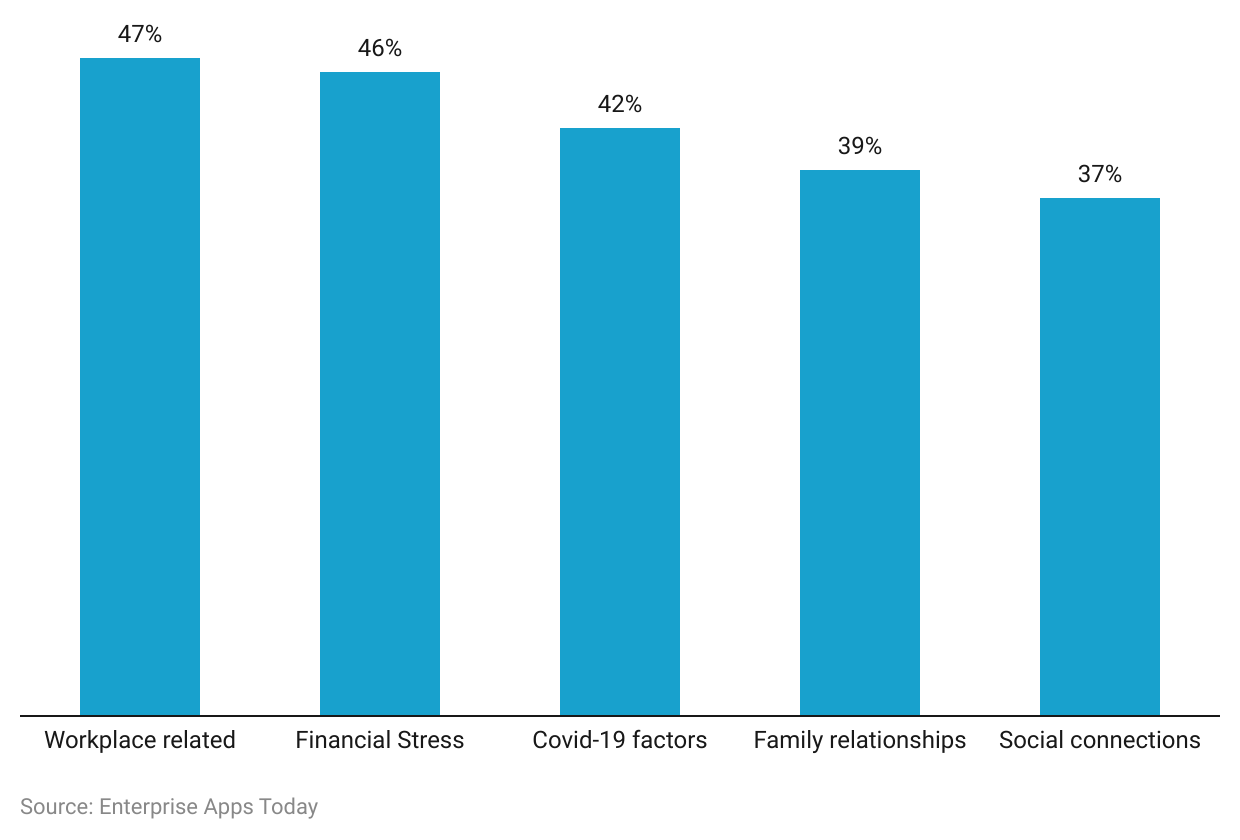 (Source: deloitte.com)
(Source: deloitte.com)
- The main cause of mental issues is stress and 47% of people around the globe state that it comes from the workplace.
- 46% and 42% of people said that the stress increased due to financial stress and COVID-19 factors respectively.
- 39% of stress leading to mental health issues is from family relationships and 37% belong to social connections.
By Workplace
- 15% of the employees talked to their bosses and 91% of them were supportive and only 9% were unsupportive.
By Industry
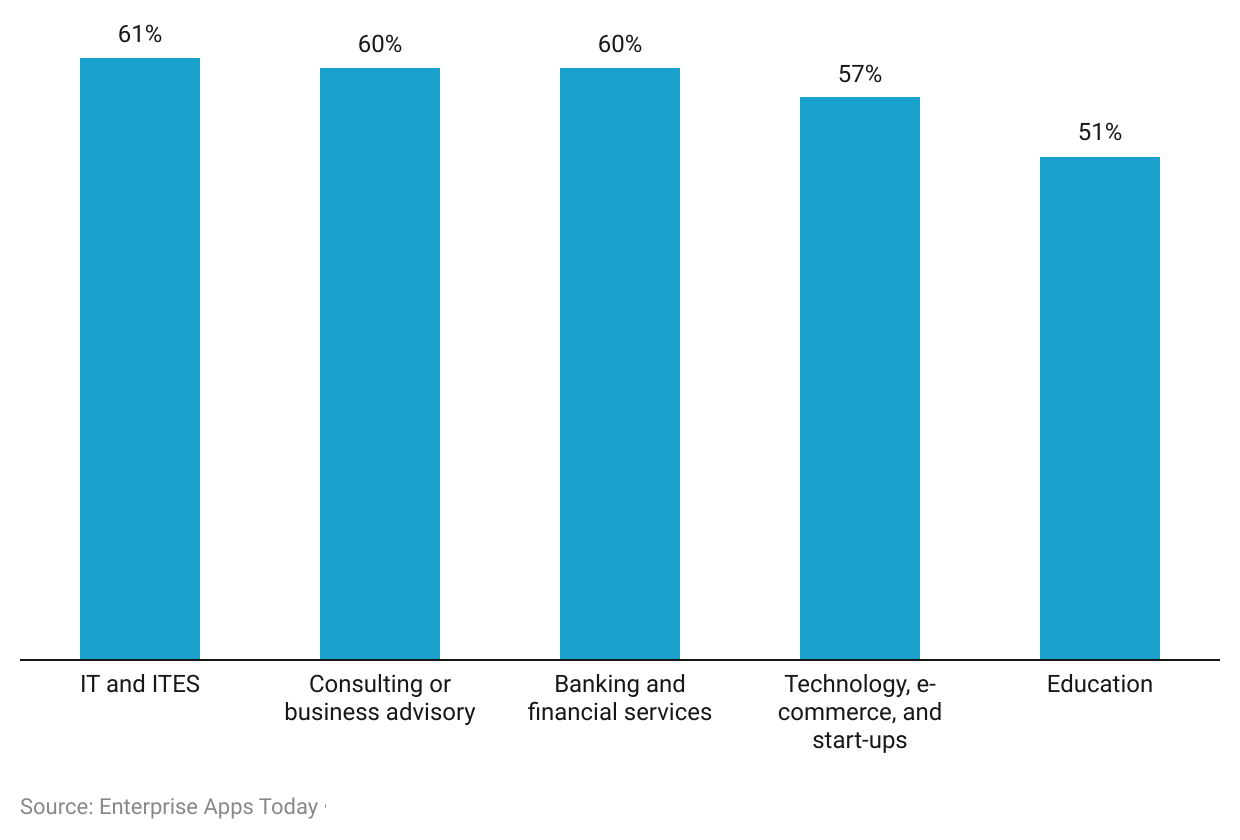 (Source: deloitte.com)
(Source: deloitte.com)
- The global mental health statistics state that the highest number of mental problems start in IT or ITES companies resulting in 61%.
- The second largest industry for employees facing mental illness is consulting or business advisory and banking and financial services at third resulting in 60% respectively.
- Technology, e-commerce, and startups contribute to mental health problems by 57% and the education sector by 51%.
By Assistance Received
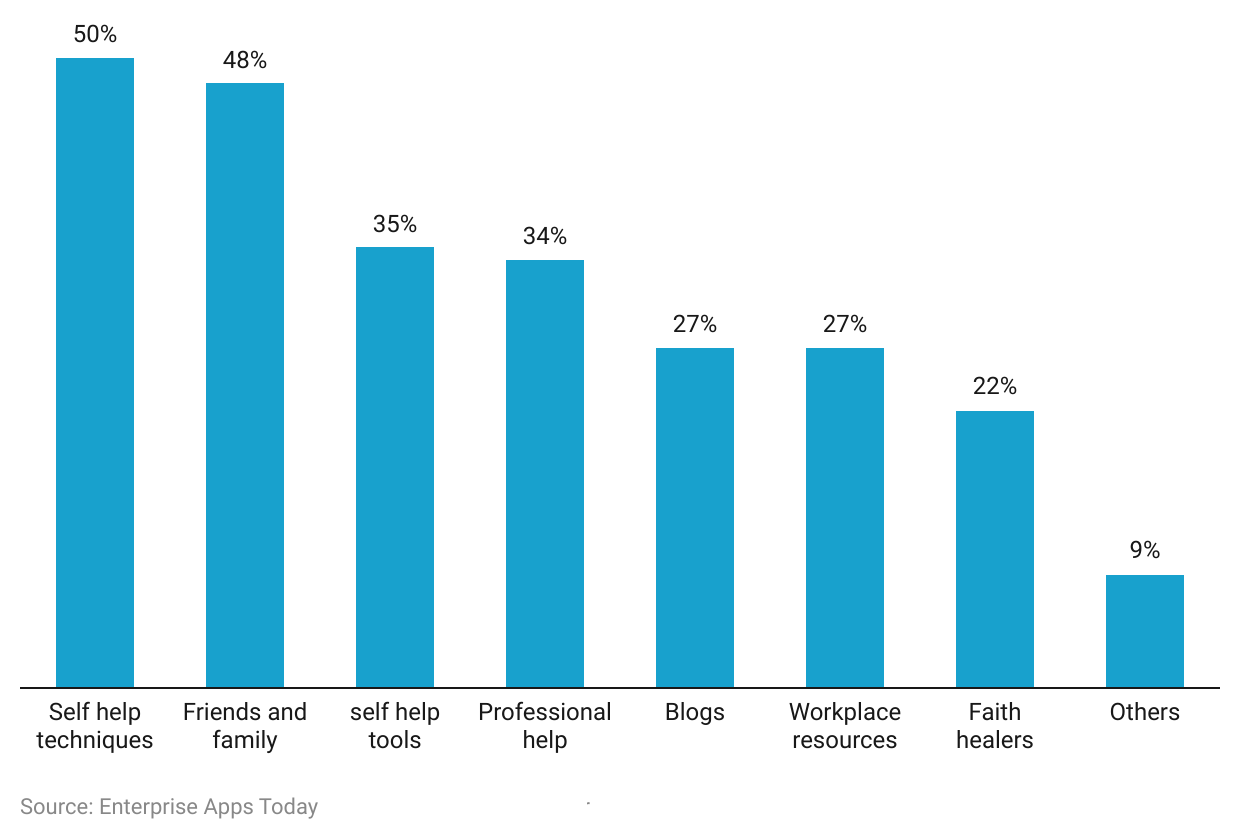 (Source: deloitte.com)
(Source: deloitte.com)
- 50% of the corporate employees facing mental health issues took the help of self-help techniques.
- 48% of the employees shared the problem with their friends and family, while 35% of the people chose to take help from self-help tools such as mobile applications.
- 34% of employees took professional help, on the other hand, 27% chose to read blogs related to mental health issues prevention and cures.
- 27% and 22% of the employees facing mental health issues took help from workplace resources and faith healers respectively.
- 9% of people chose various options.
By Treatment Received
- According to mental health statistics, 45% of the adults received treatment while 66% of them were suffering from serious mental illness and received assistance.
- 51% of the young people aged between 6 years to 17 years received treatment in the last year.
By No Assistance Received
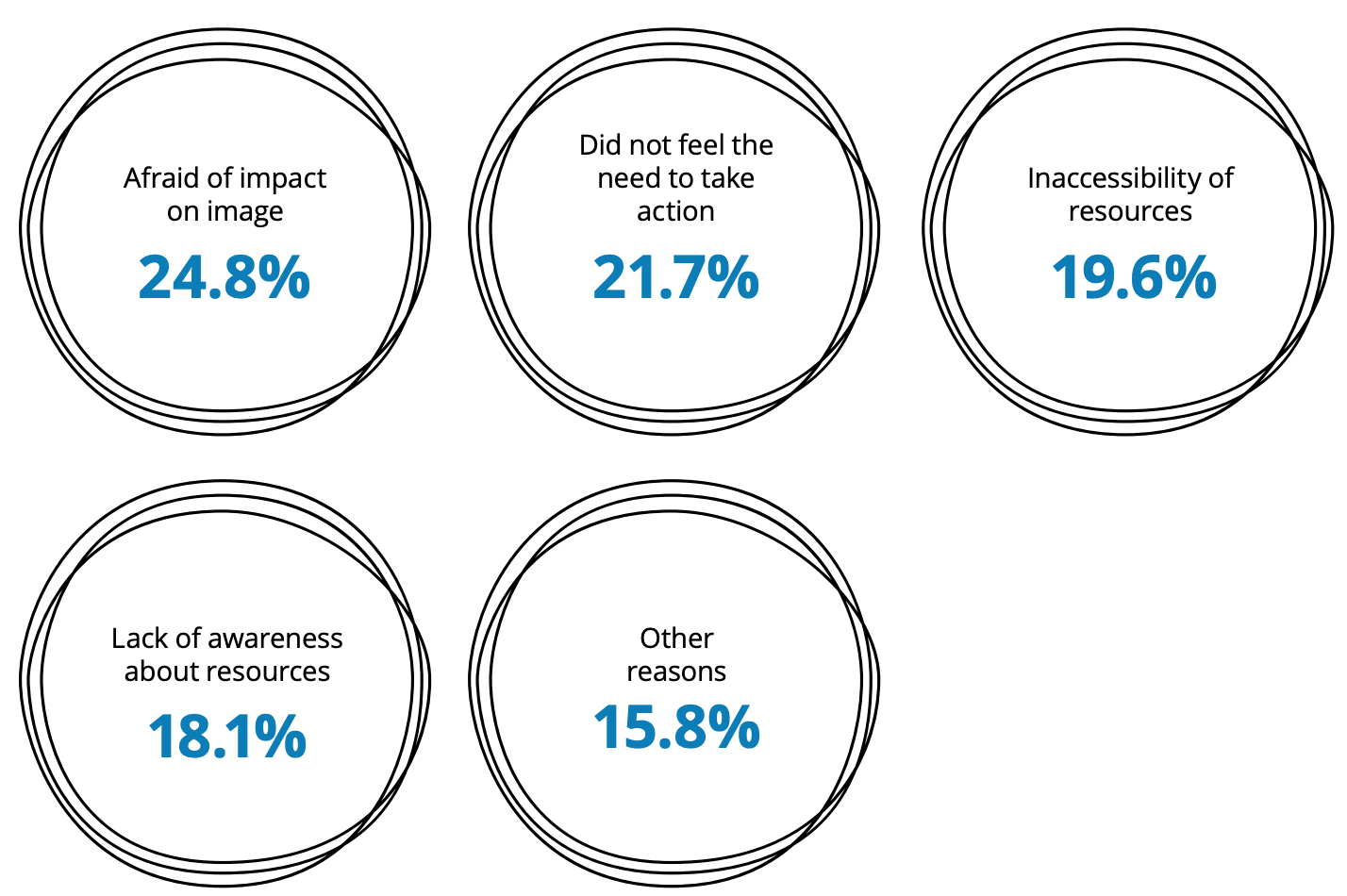
(Source: deloitte.com)
- 8% of people didn’t seek any assistance because they were afraid that their image will be impacted.
- 7% didn’t feel the need while 19.6% said there were not enough sources available to seek help.
- 1% of people with mental health issues were not aware of the resources for the needed help.
- 8% of people gave other reasons.
By Side Effects
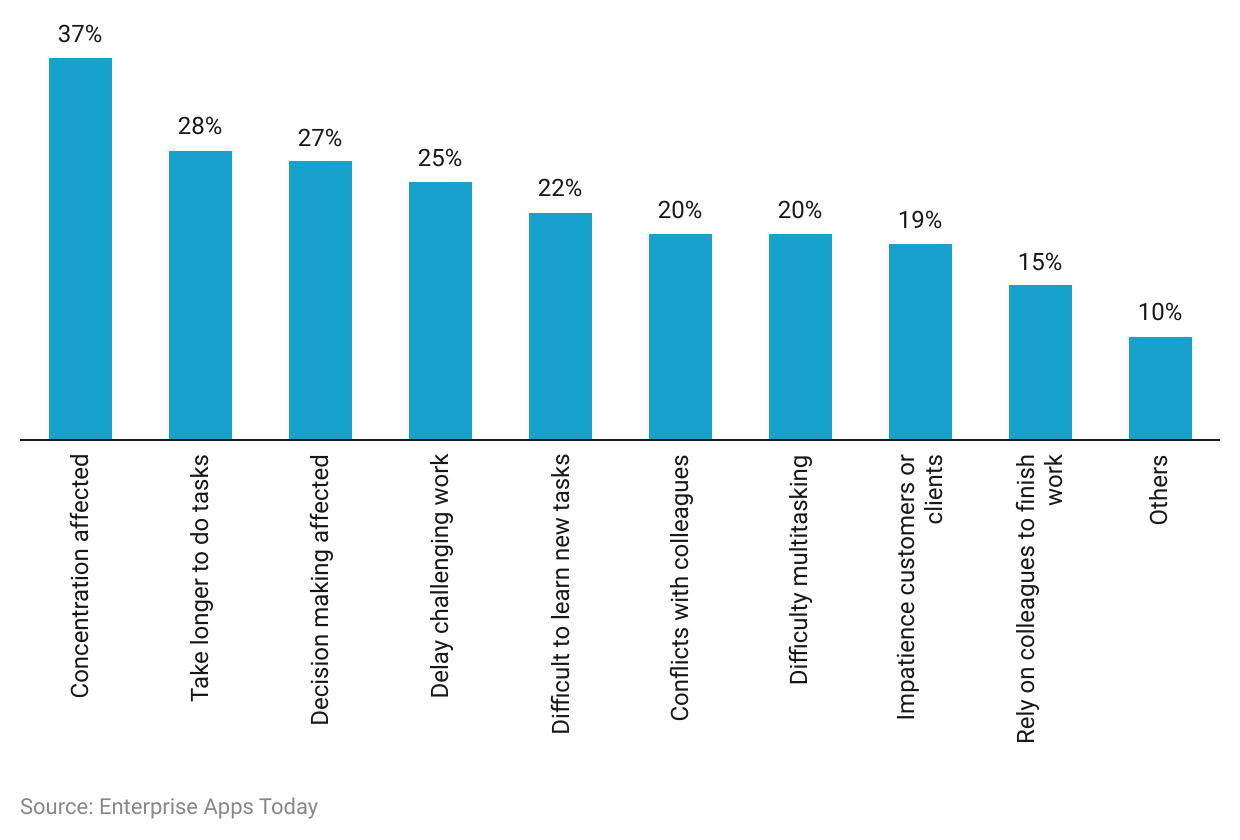 (Source: deloitte.com)
(Source: deloitte.com)
- According to mental health statistics, 37% of people say that they feel their concentration is affected due to mental health issues.
- 28% of the people facing mental health problems stated that it takes more than desired time to complete the given task.
- While 27% of the people felt that their decision-making capacity has been hampered.
- 25% and 22% of people reported delay in challenging work and difficulty to learn new tasks respectively.
- 20% of the people equally faced challenges with conflicts with colleagues and difficulty in multitasking.
- 19% of people with mental health problems were impatient with customers or clients.
- 15% and 10% people had to rely on colleagues to finish the work and the remaining faced various problems.
Mental Health Statistics By Country
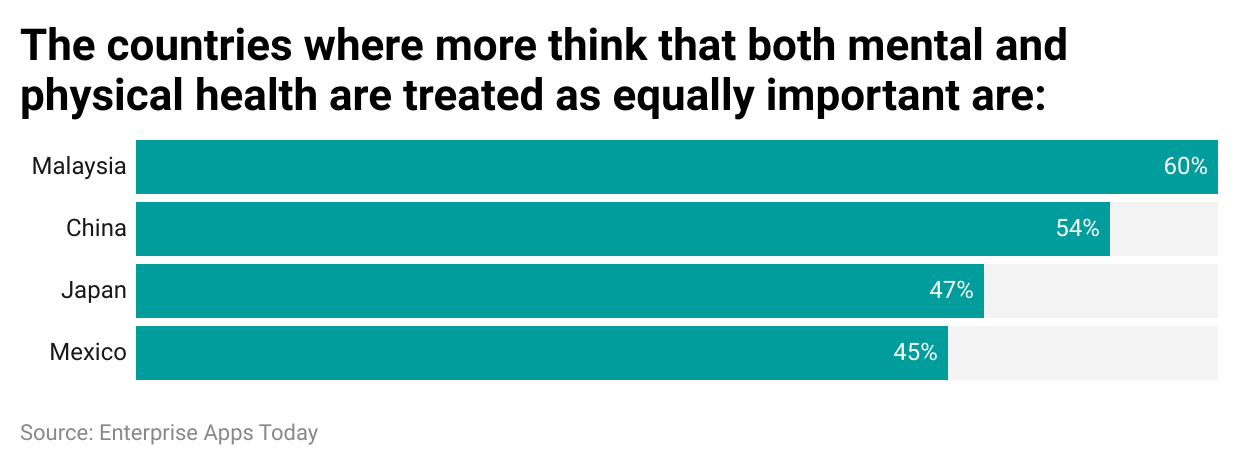 (Source: ipsos.com)
(Source: ipsos.com)
- 60% of the residents in Malaysia think that mental and physical health are similarly important.
- While only 54% and 47% of people in China and Japan think so.
- Similarly, 45% of Mexican residents second the thought of mental and physical health being treated equally.
Conclusion
Concluding the above mental health statistics, we come to know that it is now high time to take effective measures to further avoid people hampering their mental health. The majority of people face this problem because of finance and job as well as family issues. Mental health issues are curable, and it is okay to talk about them. The issues should be advised as soon as it is possible. If you know someone with such problems, don’t ignore them and let them know that they are not alone!
Sources
FAQ.
You can improve your mental health by doing meditation on daily basis, spending time with your favorite person, and going on evening or morning walks. One of the best options to reduce stress is to adopt a pet
Keeping your mind under control, anger management, physical activity, creating family values, and following life goals are some good mental health habits.
Stay with the person until he/she calms down, and don’t trigger any activities which contribute to counterattacks. Ask the person what he/she needs. Help the person calm down and ask for breathing activities. If needed seek medical help.
Every year October 10th is observed as world mental health day.

By conducting scientific research, I write about illness, health and healthcare. As a professional medical writer, my experience includes creating feature articles for newsletters and websites as well as research news stories for doctors and researchers. Reading has been an integral part of me since childhood - I'm fan of "Friends" and the "Harry Potter series". Before this career, I was employed by a French multinational company. However, my passion for reading led me to pursue writing professionally; my first Amazon-published short story entitled "The envelope that changed our lives" has recently been released. In my free moments, I enjoy long bike rides around town.


